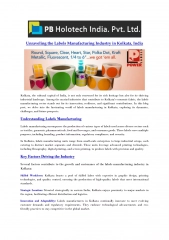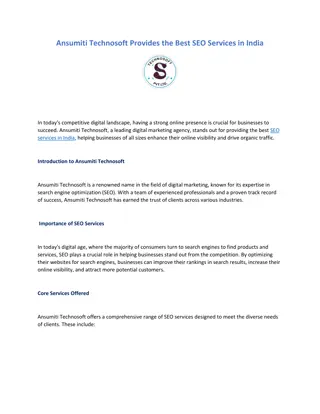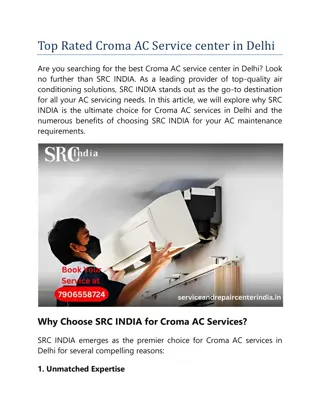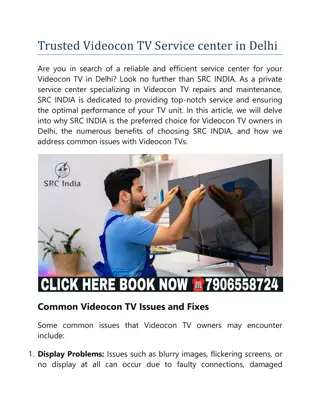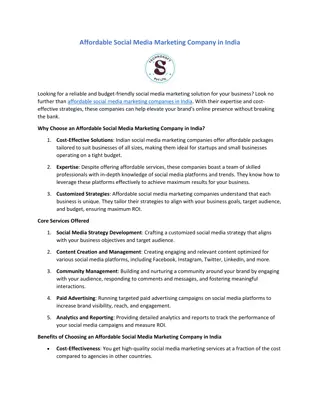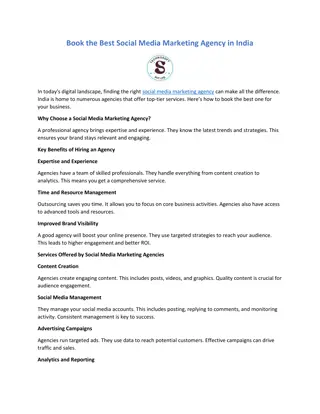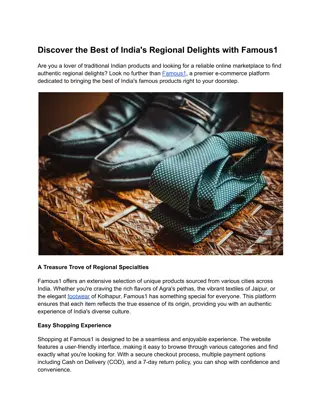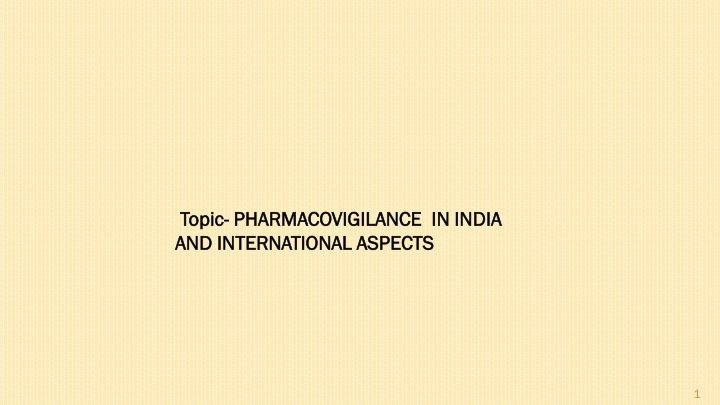
Pharmacovigilance in India: Scope, Objectives, and International Aspects
Discover the evolution of pharmacovigilance in India, from its background in 1989 to the establishment of national programs. Learn about the mission and vision to enhance patient safety by monitoring drug effects and promoting the safe use of medications.
Download Presentation

Please find below an Image/Link to download the presentation.
The content on the website is provided AS IS for your information and personal use only. It may not be sold, licensed, or shared on other websites without obtaining consent from the author. If you encounter any issues during the download, it is possible that the publisher has removed the file from their server.
You are allowed to download the files provided on this website for personal or commercial use, subject to the condition that they are used lawfully. All files are the property of their respective owners.
The content on the website is provided AS IS for your information and personal use only. It may not be sold, licensed, or shared on other websites without obtaining consent from the author.
E N D
Presentation Transcript
Topic Topic- - PHARMACOVIGILANCE IN INDIA PHARMACOVIGILANCE IN INDIA AND INTERNATIONAL ASPECTS AND INTERNATIONAL ASPECTS 1
CONTENT : - Introduction Pharmacovigilance in India Scope and Objectives Mission Vision Short Term Goals 2 MADE BY SATENDRA CHAUHAN
MADE BY SATENDRA CHAUHAN PHARMACOVIGILANCE IN INDIA Introduction : Introduction :- - Pharmacovigilance is a system to monitor the safety and effective of medicines and other pharmaceutical products. As per WHO : As per WHO :- - Pharmacovigilance as science and activities relating to the detection assessment, understanding and prevention of adverse effects or any other possible drug- related problems . 3
PHARMACOVIGILANCE IN INDIA Background Background :- 1989 ADR monitoring system for India proposed ( 12 regional centers) . 19987 India joined WHO- ADR monitoring programmed ( 3 centre's : AIIMS, KEM (King Edward Memorial ), , AMU ( Aligarh Muslim University ) 2004 2008 National Pharmacovigilance Programmed . ( * 2 Zonal , * 5 Regional , * 24 Peripheral , * Overseen by CDSCO ) 2010 Pharmacovigilance Programmed of India . 4 MADE BY SATENDRA CHAUHAN
MISSION OF PHARMACOVIGILANCE PROGRAM IN INDIA Initiated with AIIMS, New Delhi as National Coordination Centre (NCC) for monitoring ADRs in the country July 2010, shifted to India Pharmacopoeia Commission (IPC) , Ghaziabad on 15th April 2011 . Vision : Vision :- - To improve patient safety and welfare of India population by monitoring the drug safety reducing the risk associated with use of medicines. Mission : Mission :- - Safeguard the health of the Indian population by ensuring that the benefits of use medicine outweigh the risk associate with its use . 5 MADE BY SATENDRA CHAUHAN
6 MADE BY SATENDRA CHAUHAN
NATIONAL PHARMACOVIGILANCE PROGRAM (NPP) The National Pharmacovigilance Program (NNP) officially inaugurated by the Central Health Minister at New Delhi. 7 MADE BY SATENDRA CHAUHAN
OBJECTIVE OF PHARMACOVIGILANCE PROGRAMMED OF INDIA To create a nation system for patient safety reporting. To identify and analyse the new signal ADR from the reported cases. To generate the evidence- based information on safety of medicines. To support regulatory agencies in the decision- making process on use of medicines. To communicate the safety information on use of medicine to various stakeholders to minimize to the risk. To provide training and consultancy to other national Pharmacovigilance centers locates across globe. To collaborate with other national centre's for the exchange of information and data management. To promote rational use of medicine. 8 MADE BY SATENDRA CHAUHAN
SHORT TERM GOALS To develop and implement pharmaco-vigilance system in India. To enroll , initially , all MCI approved medical colleges in the program covering north, south , east and west of India. To encourage healthcare professionals in reporting of adverse reaction to drugs, vaccines, medical devices and biological products. Collection of case report and data. 9 MADE BY SATENDRA CHAUHAN
LONG TERM GOAL To expand the Pharmacovigilance programme to all hospitals ( govt. & private ) and centers of public health programs located across India. To develop and implement electronic reporting system ( e- reporting ). To develop reporting culture amongst healthcare professionals. To make ADR reporting mandatory for healthcare professionals. 10 MADE BY SATENDRA CHAUHAN
PERFORMANCE & EFFECTIVENESS OF THE PHARMACOVIGILANCE SYSTEM Who can Report What to Report Whom to Report All type of suspected ADRs- irrespective of whether they are know or unknown, serious and non-serious, frequently or rare. Although Pharmacovigilance is primarily concerned with pharmaceutical medicines, adverse reactions associated with drugs used in traditional medicine ( e. g. herbal remedies ) should also be considered. Healthcare professionals (clinical, dentist , pharmacist, nurses and other) can report suspected adverse drug reaction. Pharmaceutical companies can also send ICSRs specific for their product to NCC. Use the Suspected Adverse Drug Reaction Reporting from which is available on the official website of IPC ( www.ipc.gov.in ) as well as CDSCO ( www.cdsco.nic.in ) to report any ADR. A reporter who is not a part of AMC can submit the ICSR to the nearest AMC or directly to the NCC. 11 MADE BY SATENDRA CHAUHAN
ORGANIZATION COMMITTEES UNDER NCC This :- Steering Committee Working Group Quality Review Panel Core Training Panel Signal Review Panel 12 MADE BY SATENDRA CHAUHAN
NCC WORKING MODULE Letter of intent AMCs Coordinator NCC - PvPI Examine the Suitability Approved by NCC Vigi- Flow login provided by NCC to AMCs AMCs- To perform the causality of the ADRs and furnish the mandatory field in the suspected ADRs form AMCs- upload the ADR in Vigi- Flow send to NCC PvPI 13 MADE BY SATENDRA CHAUHAN
14 MADE BY SATENDRA CHAUHAN
RESPONSIBILITIES OF STAKEHOLDER Personnel at AMC : Personnel at AMC :- - Collection of ADR reports. Perform follow up the complainant to check completeness as per SOPs. Reporting to PvPI National Coordinating Centre. Training/ sensitization / feedback / to physicians through newsletters circulated by the PvPI NCC. 15 MADE BY SATENDRA CHAUHAN
PERSONNEL AT NCC Preparation of SOPs, guidance documents & training manuals. Data collation, Cross- cheek completeness , Causality Assessment etc as per SOPs. Conduct Training workshops of all enrolled centers Publication of Medicines Safety Newsletter. Reporting to CDSCO Headquarters. Analysis of the PMS, PSUR, AEFI data received from CDSCO HQ. 16 MADE BY SATENDRA CHAUHAN
MADE BY SATENDRA CHAUHAN PERSONNEL AT ZONAL/ SUB ZONAL CDSCO Provide procurement , financial and administrative support to ADR monitoring centers. Report to CDSCO HQ Personnel at CDSCO HQ Personnel at CDSCO HQ : : - - Take appropriate regulatory decision & action on the basis of recommendation of PvPI NCC at IPC Ghaziabad. Propagation of medicine safety related decision to stakeholders. Collaboration with WHO- Uppsala Monitoring Centre Sweden. Provide for budgetary provisions & administrative support to run PvPI. 17
PHASE OR ROAD MAP OF PVIP Initiation phase (2010 2011 ) Expansion and consolidation phase ( 2011-2012) Expansion and maintenance phase (2012- 2013). Expansion and optimization ( 2013 2014 ) Excellence phase ( 2014 2015 ). 19 MADE BY SATENDRA CHAUHAN
VIGIFLOW Vigiflow is an Individual Case Safety Report ( ICSR) management system developed and hosted by Uppsala monitoring centre(UMC) . How to access Vigiflow Web address : https://adr.who-umc.org Log in is done with a personal user name and password From the secure web page. 20 MADE BY SATENDRA CHAUHAN
VIGIFLOW The minimum information you have to enter on a spontaneous report for it to be considered complete by Vigiflow is the following six mandatory fields :- 1. 2). 3). 4). Onset date 5). Reaction term 6). Drug name Patient age (either DOB, age at time of onset or age group) Patient initial Report tile 21 MADE BY SATENDRA CHAUHAN
VIGIFLOW DEMO CHART Login with Id and password Quick start 1 2 3 REPORT INFO PAGE PATIENT PAGE TEST and Procedures RELEVANT MEDICAL a) Patient Characteristics Page b) Death related information a) Result from test and a) Report information procedure section Free text Structured b) Information on sender b) test information information c) Information on Primary source 4 HISTORY PAGE Free information Structured information 22 MADE BY SATENDRA CHAUHAN
7 5 6 RELEVANT PAST DRUG THERAPY DRUG PAGE a) Suspected Drugs b) Concomitant Drugs REACTION PAGE a) Reaction / Events- free text b) Relatedness of Drugs to reaction 1 7 2 3 4 5 6 The CAUSALITY ASSESSMENT Save Report Save to NCC Submit Report to UMC 23 MADE BY SATENDRA CHAUHAN
T H A N YOU 24 MADE BY SATENDRA CHAUHAN



